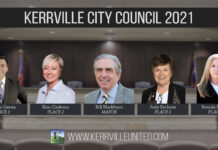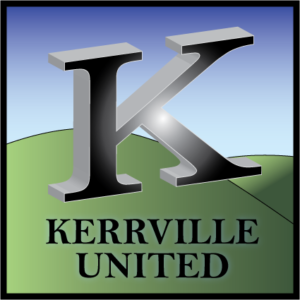Kerrville’s City Council will consider a new set of “deal points” on Tuesday night as it wrestles with a decision about a newly-proposed 500-home subdivision just south of Riverhill. The proposed development, known as Vintage Heights, would establish approximately 500 lots for residential construction. The decision comes against the backdrop of a demonstrated critical shortage of “affordable” or “workforce” housing (depending on which definition is used) in Kerrville.
Vintage Heights was presented to the Planning & Zoning Commission (P&Z) but the case was not approved. The developer appealed the case to the City Council, and this item will be on the agenda Tuesday night. To overturn P&Z’s ruling, Council must pass the motion with a three-fourths vote — effectively needing at least four votes in the affirmative if all five council members are present. In concert with the zoning appeal, the developer and city staff have worked out several “deal points” that are offered in tandem with the zoning change to make the proposal more palatable to neighbors in Riverhill.
Several actions by council would be needed if they choose to approve the new deal on the table. The first action would be approval of a change in zoning from R1 to R2. This is a zoning ordinance, so a second reading would be required at the next council meeting on January 28 to make that official. The next action that would be required would be to authorize the city manager to execute the “deal points” memorandum stipulating the concessions made by the developer and by the city. Then a more formal development agreement would also need approval on January 28, incorporating those deal points. So, multiple actions are required over the course of the next two council meetings to give Vintage Heights a “green light,” should council elect to do so.
This lengthy article aims to present the reader with all of the relevant information to be informed on this important matter that comes before our City Council on Tuesday, January 14, 2020.
Workforce Housing Crisis
According to multiple local organizations, real estate agencies, and government studies, Kerrville is critically short on the supply of workforce housing (sometimes referred to as “affordable” housing). Kerrville Area Chamber of Commerce president Walt Koenig wrote in the Kerrville Daily Times that there are “extremely limited housing options for those wishing to have a career in our community.”
We have a shallow labor pool and extremely limited housing options for those wishing to have a career in our community.
Walt Koenig, President & CEO of Kerrville Area Chamber of Commerce
Along with much of the country, Kerrville’s home prices continue to rise at twice the rate of wage growth, and simultaneously, the demand for housing has outstripped the supply of affordable homes in Kerrville. (Ref.: Keeping Up with Kerrville, July 5, 2019) Nationally, the National Association of Realtors predicts that, “A lack of homes for sale has been making things difficult for buyers since 2015, and [in 2020], inventory could reach historic lows.”
The issue of housing came up more often than any other during the election campaigns of 2018 and 2019, and in response, council launched a Task Force on Workforce Housing consisting of builders, real estate professionals, and residents. The task force guided the creation of the “Kerrville Housing Study and Strategic Plan 2019,” a document that laid out the challenges and potential remedies for the shortage of affordable housing in our community.
With at least 300 new jobs coming to Kerrville over the next few years, according to estimates from the Kerr Economic Development Corporation, the shortage could become even worse. The study concluded that if new housing options are not constructed in the near term, the gap between the supply and demand for housing will force these new job-takers to seek housing outside of the city or even outside of Kerr County, causing our community to miss out on the full economic benefit of all those new jobs.
Housing is critical to economic development
Economic development and housing are inextricably connected. During a meeting of the Economic Improvement Corporation (EIC) on January 13, 2020, Gil Salinas of the Kerr Economic Development Corporation noted that one of the most exciting economic development prospects currently considering Kerrville as a place to expand operations and bring up to 200 jobs over the next 3-5 years is watching Tuesday night’s vote very closely. One of the biggest concerns that potential employers have when looking at Kerrville is our workforce, and where to house new workers when companies provide new jobs.
In addition to that prospect, preparations are underway to add approximately 200 jobs at the Kerrville State Hospital. Other local employers have plans for expansion, too. And until the housing situation is stabilized, the demand for housing will continue to outstrip the supply.
The communities that figure out how to effectively address the work force housing issue will win and those who don’t will lose. It’s really just that simple.
Walt Koenig, President & CEO of Kerrville Area Chamber of Commerce
Background: Riverhill
Riverhill subdivision was first developed in 1974, boasting a golf course designed by Joe Finger, renown golf course architect, with input from golf legend Byron Nelson. The very first subdivision plat was filed in December 1974 consisting of Riverhill Boulevard, Spring Mill, Lakewood, Highlands, and other smaller streets, including several “stub outs” on Ridgewood Lane, Hickory Hills Drive, and Green Tree Lane, for future development connections.
Riverhill Boulevard was dedicated as a public street and designed as what we would today designate a “collector street.” The purpose of collector streets is to connect neighborhoods and residents to “arterial streets,” or more significant roadways that connect to destinations. All of the traffic from original neighborhoods in Riverhill Estates No. One was designed to “collect” onto Riverhill Boulevard and then connect to Highway 16 (and later, Highway 173).
Riverhill was annexed into the City of Kerrville in 1984 when its private utility district became overwhelmed by the growth taking place in the development.

Additional neighborhoods in Riverhill were added in the subsequent decades. Some neighborhoods featured single family detached housing, zoned R1, and others contained townhomes, condominiums, and similar designs within an R2 zoning designation. Currently there are at least seven distinct neighborhoods in Riverhill zoned R2 (medium density residential).
Including the golf course and other club facilities, public streets, etc., the collection of neighborhoods and subdivisions, all referred to colloquially as “Riverhill,” contains approximately 540 acres. Of that 540 acres, about 150 acres comprises the golf course and club land — approximately 28%.
About 146 acres of that collective landmass known as Riverhill is currently zoned R2 — about 27% of the entire Riverhill area is R2. If you remove the golf course and country club from that equation, then about 37% of the land is zoned R2, and 63% is zoned R1 or similar. Keep this in mind for comparison with the plans for Vintage Heights further down the page.


Traffic on Riverhill Boulevard
Residents have protested about the amount (and type) of traffic on Riverhill Boulevard for decades. A recent study showed that the street receives approximately 1,230 vehicles per day — 32 of which were tractor trailers. So in June 2019, City Council passed a new ordinance prohibiting large trucks from traveling down Riverhill Boulevard. This was not the first time that measures were taken to reduce the quantity or type of traffic on Riverhill Boulevard.
Traffic actually decreased on Riverhill Boulevard between 2013 and 2019. According to two traffic studies six years apart, the number of vehicles per day decreased from a range of 1,488-1,636, down to an average of 1,230 vehicles per day in 2019.
Some of the other measures that have been taken over the years include:
- 1986 — Ordinance prohibiting trucks over one ton from traveling down RHB.
- 2002 — Signs erected prohibiting vehicles over 7,000 pounds from traveling down RHB.
- 2012 — Commissioned traffic study to find ways to calm traffic.
- 2012 — Stripes painted on roadway.
- 2012 — City approves “road hump policy” and stop signs.
- 2014 — Roundabouts installed on RHB.
- 2016 — TxDOT erects traffic signal at intersection of RHB and Highway 173.
- 2018 — County sends resolution to TxDOT asking for “relief route” to alleviate traffic on RHB.
- 2018 — Roundabouts repaired and reworked.
- 2019 — Prohibition of large trucks on RHB.
The traffic issues affecting Riverhill Boulevard are a distinct and separate issue from the proposed Vintage Heights development, but the two are not completely disconnected. A traffic study commissioned by the developer and presented to P&Z in December concluded that Vintage Heights would not have a significant impact on the traffic patterns on Riverhill Boulevard. Traffic was a problem before Vintage Heights, and will continue to be an issue whether or not Vintage Heights is approved and developed. There are no clear remedies to this issue that has been present practically since the street’s completion.
It is notable that Vintage Heights is within the city limits of Kerrville, and therefore the city has the ability to exert some control over its development and street connections (which we will discuss below). However, if another development were built outside the city limits but with the same number of proposed homes, the city would have little to no control over that development, other than assuring compliance with the subdivision ordinance, and Riverhill Boulevard would potentially receive the same amount of traffic from residents who do not pay city taxes to maintain the streets and infrastructure.
A future project that does have the potential to alleviate some of the through traffic along Riverhill Boulevard is the proposed arterial street that would connect Highways 16 and 173 south of Riverhill and south of the Kerrville-Schreiner Park. That hypothetical future street is part of the city’s Thoroughfare Plan adopted as part of the Kerrville 2050 Comprehensive Plan.
Vintage Heights plans to dedicate a portion of the right-of-way for this planned arterial relief route, but the remainder of the right-of-way acquisition is dependent upon the development of the private property between Vintage Heights and Highway 173. Due to restrictions placed on the Kerrville-Schreiner Park by the State of Texas when the park was conveyed to the City of Kerrville, the roadway cannot be constructed through the parkland. So the route must run southeast of the park, through land currently owned by private landowners. If that land were to be developed, the city could require that the developer dedicate right-of-way that would be used for the arterial street that’s on the thoroughfare plan. But since there are no current plans for development on that private land, the route is not on the radar for the near future.

The bottom line for the traffic situation on Riverhill Boulevard is that there are no easy fixes on the horizon. As long as it is perceived as a shortcut between highways, vehicles will continue to use the road, and because police have limited resources, traffic laws and city ordinances cannot be enforced 100% of the time. Riverhill Boulevard is not unique in this way — other residents in other neighborhoods have their own share of complaints on streets like Coronado, Lois, Guadalupe, Harper Street, Galbraith, Paschal, Tivy, and many more. Traffic will always be a concern for residents along routes that drivers find convenient, and safety should be prioritized in these areas. But development cannot cease while we sort these problems out. Kerrville must find a way to safely manage traffic while at the same time cultivating responsible growth.
Understanding Vintage Heights
Vintage Heights is the name for the approximately 226-acre, 500-home development proposed just south of Riverhill subdivision. The exclusive construction contractor is D.R. Horton, a Fortune 500 company founded in 1978 that operates in 29 states. The homes will be priced (primarily) between $180,000 and $227,000. That upper limit is extremely important here because it represents the current ceiling for “workforce housing” prices in our market.
(Note: The Texas Department of Housing and Community Affairs sets the target prices for workforce housing based on 80-120% of the average median income in a community. The $227k number could change over time due to inflation, changes in the median income, etc.)
Zoning
The primary reason that this development has received so much government and public scrutiny is because the developer has requested a zoning change from R1 (single-family residential) to R2 (medium density residential). As we mentioned above, Riverhill contains a mixture of R1 and R2 zones, with many single family residential structures as well as many townhomes and condominiums. But the zoning classification for the 226 acres where Vintage Heights is proposed to go is currently zoned R1. The P&Z denied that request to change to R2, and the developer appealed to the council to override the P&Z. That’s where we are now.
But it’s important to note that a different development could be proposed today without any zoning change, and therefore no opportunity for the city to ask for the concessions that we’ll discuss below. If the property kept its R1 zoning classification, and another developer attempted to maximize the number of units on that land, theoretically up to about 700 homes could be built without any special approval by the city. And in that case, the subdivision ordinance would still apply, requiring those connections to the streets stubbed out in Riverhill. It’s only thank to the developer’s desire to change the zoning to R2 that the city now has this opportunity to ask for certain concessions from the developer.
Preliminary Plat
The development is proposed in two phases, with the first phase adjacent to Riverhill, and the second phase being further south along Highway 16. Several roads wind through the subdivision and connect the arterial (Highway 16) to collector streets within the development, and finally to residential neighborhood streets that serve the individual lots.
In the original proposal that was submitted to P&Z for preliminary plat approval, the new streets would connect to the existing “stub outs” in Riverhill, namely, Green Tree Lane, Hickory Hills Lane, and Ridgewood Drive — those same streets that you’ll recognize from the 1974 plat of Riverhill Estates Number One. Kerrville’s subdivision ordinance required that the developer connect those stub-outs to his newly proposed streets within the subdivision, and the plan was presented to P&Z with those connections. However, as part of a new set of “deal points” that would be part of a new development agreement, the developer has adjusted the layout so that those streets would no longer connect. (The P&Z had no authority to waive the subdivision ordinance requirements, but council can do so as part of a development agreement, which is proposed for consideration on Tuesday night.)

This deal point is one of several concessions that the developer has agreed to abide by. Council will weigh these deal points on Tuesday night, as well as the city’s commitments that have been offered to the developer by city staff, subject to council approval. Some of the major new points include:
Developer Commitments
- No street connections into Riverhill — The existing “stub outs” would be left as they are, fenced off, and the new development would not have access through those three streets (Green Tree, Hickory Hills, Ridgewood)
- Fencing along boundary with adjacent Riverhill property owners — 8′ tall wooden privacy fence
- Larger lots adjacent to Riverhill, sized as they would if zoned R1
- Only single story homes within 100 feet of Riverhill
- Phases 1 and 2 limited to single family homes
- Construction and landscaping requirements for the new homes
- At least 40% of the development must be left as open space
- Construction of two parks totaling 12 acres, including two playgrounds
- Developer constructs all utilities as per city codes
City Commitments
- 45% property tax rebate for 20 years from the date the first home goes on the tax rolls (homes must be priced at or under $227,000 for this exemption, and the total exemption will be capped at $5 million)
- Terminate prior development agreement
- Accept proposed street configurations
If these deal points are agreed to and the subdivision is constructed according to these stipulations, the composition of the land mass would be 60% homes and streets, and 40% open land and parks. Earlier we discussed the composition of Riverhill. Now we can compare the two. As you can see, theoretically, Vintage Heights will have an even higher percentage of open space and parks than Riverhill currently contains. The difference is that the open space in Vintage Heights will not include a golf course.


Concessions
These deal points were struck between city staff and the developer after the P&Z meeting in December. Several meetings took place between council members and residents of Riverhill; between city staff and the developer; and between other city officials and numerous other stakeholders. These issues were hammered out and agreed upon by the developer, and Mr. Chuck Cammack has already affixed his signature to a memorandum of understanding outlining these various deal points. If approved by council on Tuesday night, a more formal document will be drafted and executed.
The developer makes many of these concessions at significant cost. Design costs have been incurred to reconfigure the development to meet the more stringent requirements agreed to in the deal points. Changing the lot sizes and agreeing to certain styles and sizes of homes near Riverhill may affect the bottom line profit as well as the number of housing units offered. Construction of a wooden fence will add expense. Parks and playgrounds will cost the developer. Each of the concessions will have an effect on the developer’s bottom line. The city also agrees to a reduction in future revenues by offering the tax rebate, as well as other concessions that could set precedents for future development agreements.
Both sides have agreed to give a little (or a lot, depending on your perspective) to make this deal happen. Will the deal satisfy all the complaints made by neighbors in Riverhill or opponents that live in other parts of town? Certainly not. But the good-faith efforts applied to this negotiation must be applauded.
Property Tax Rebates
Tax rebates are one form of incentives sometimes offered to developers to entice them to pursue a project or meet some goal. Tax incentives like these are looked upon favorably by many municipalities because they do not require any outlay of cash on the front end — all of the money changes hands on the back end after some revenues have been collected that would not have been collected otherwise.
Here’s how it will work… If approved this month (final approval would not happen until January 28 on the second reading of the zoning ordinance), the developer will go ahead with plans for the development and will begin constructing utilities, roads, and homes. When the first home is sold, as long as the sales price is under $227,000, the incentives kick in. Here’s that $227k number again (we told you it was important). As we mentioned above, that $227k number could shift if the average median income changes, or due to inflation, etc.
The city wants to incentivize the developer to keep prices low so that the development helps alleviate our housing shortage. Normally, in the free market as it exists today in Kerrville, contractors have an incentive to build more expensive homes to maximize their profits. But the city’s position is that we need more lower-priced homes, not more high-end custom homes. So the city has to bring something to the table to incentivize the developer to achieve this goal that we have as a community: workforce housing.
That first home that is sold — we’ll call it Home Zero — changes hands and is now owned by a proud new homeowner. That property is placed on the tax rolls and the new property owner will begin paying taxes to the City of Kerrville, Kerr County, Kerrville ISD, and other taxing entities. Whatever portion is paid to the city, 45 percent of that will then be refunded (or rebated) back to the developer.
The city has placed a limit on this rebate program. The total amount rebated to the developer will not exceed $5 million and the time period will not exceed 20 years.
The math depends on many factors, but with conservative forecasting, the incentive averages out to be just under $10,000 per unit. That is, the developer is given back about $10,000 per house that is sold under $227,000.
This is not the first time that the City and/or the Economic Improvement Corporation (EIC) has offered incentives to residential developers. In the more distant past, EIC money helped establish developments with the Home Opportunity Council and Habitat for Humanity. In the more recent past, the city has incentivized The Landing development on Thompson Drive.
What about water?
In a community that’s dependent on water from the Guadalupe River and our aquifers, understanding our water supply is vital to the future of our city. One of the questions that has been asked is, “Do we have enough water supply and infrastructure to support 500 new homes?” According to city officials, the answer is “Yes.”
The city anticipated this question and has provided some information in the agenda packet for Tuesday night. More information will be provided during that portion of the city’s presentation to council. According to that presentation…
- Although specifics were unknown at the time, the eventual development of this 226 acre property was anticipated and included in the 2008 Water and Wastewater Master Plan.
- Five new projects were built that help support the infrastructure needs to get water to this area. All five projects are complete.
- Water capacity is available to meet the increased demand of Vintage Heights.
The city has taken multiple steps in recent years to ensure our supply of water for the foreseeable future. Most recently, the construction of a large water reuse pond along with distribution lines takes the pressure off of our water supply for major irrigation purposes such as the Riverhill golf course, Schreiner University, the sports complex, and other users. And an additional ASR well allows the city to store and access water from the aquifers in times of need. Combined with several other efforts both small and large, our city does have the capacity to grow and supply water to its residents.
Conclusions
We hope you find this article useful. In a document that’s this lengthy and that includes so much information, mistakes are almost inevitable. So we hope that, if you do find an error, you’ll let us know by reaching out on Facebook at Kerrville United, or on Twitter @KerrvilleUnited.
The City Council faces a difficult decision on Tuesday night. We hope that everyone who attends comes to the meeting with a spirit of cooperation. After all, we’re all neighbors, our children attend the same schools, we travel the same roads, and we worship at the same churches. Our City Council is made up of volunteers who give of their time for no monetary compensation in return. We may not agree on specific issues like this one, but we can all agree that we want what’s best for the future of our community.
Catch the meeting on Tuesday night on the City’s streaming page: http://player.frontlayer.com/live/fl518492
References
- “Workforce housing is essential.” Kerrville Daily Times. January 13, 2020.
- “National Housing Forecast.” Realtor.com. December 4, 2019.
- Keeping Up with Kerrville, July 5, 2019. Mark McDaniel, Kerrville City Manager
- Due to time constraints, some references have been omitted, but will be added as time allows.
- Some information was gleaned during interviews with city council representatives, city staff, and other stakeholders.
Authored by Aaron Yates of Kerrville United





